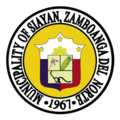Top Qs
Timeline
Chat
Perspective
Siayan, Zamboanga del Norte
Municipality in Zamboanga del Norte, Philippines From Wikipedia, the free encyclopedia
Remove ads
Siayan, officially the Municipality of Siayan (Cebuano: Lungsod sa Siayan; Subanen: Benwa Siayan; Chavacano: Municipalidad de Siayan; Tagalog: Bayan ng Siayan), is a municipality in the province of Zamboanga del Norte, Philippines. According to the 2020 census, it has a population of 36,236 people.[5]
Remove ads
History
On October 1, 1964, President Diosdado Macapagal signed Executive Order No. 114, creating the municipality of Siayan by separating part of Sindangan.[6][7] It was among those executive orders issued to create 33 municipalities, even their respective legislative bills did not pass Congress. However, vice-president Emmanuel Pelaez filed a special civil action for a writ of prohibition to void such issuances, which was unanimously granted by the Supreme Court in 1965 (Pelaez v. auditor general).[8]
On June 17, 1967, Republic Act No. 4989 was enacted without executive approval,[9][10] eventually recreating the municipality by separating 16 barrios, as originally proposed,[6] from its mother entity.[9]
In 1971, the seat of government was transferred from originally-designated Paranglumba to Siayan Proper.[11] Barrio Siayan was created in 1959.[12]
Its territory was reduced in 1982 when the southern part was organized into a separate municipality, Godod, by virtue of Batas Pambansa Blg. 146.[13]
Remove ads
Geography
Barangays
Siayan is politically subdivided into 22 barangays. Each barangay consists of puroks while some have sitios.
- Balok
- Balunokan
- Datagan
- Denuyan
- Diongan
- Dumogok
- Dumpilas
- Gonayen
- Guibo
- Gunyan
- Litolet
- Macasing
- Mangilay
- Moyo
- Muñoz
- Pange
- Paranglumba
- Poblacion
- Polayo
- Sayaw
- Seriac
- Soguilon
Climate
Remove ads
Demographics
Inhabitants in the municipality are Subanens, comprising about 70%,[15] and Visayan migrants.[10]
Economy
Summarize
Perspective
Siayan was consistently the country's poorest municipality from 2003 to 2009,[15][21] with almost the entire population (97.5% in 2006 and 2009) living below the poverty threshold based on data from the National Statistical Coordination Board.[15][22] Education was also the problem, particularly to Subanens. Due to efforts by the local government to reduce the poverty incidence which was reduced by 50% by 2016, with households affected by food shortage decreased significantly from 25.22% to 1.17% within eight years until that year, the municipality reportedly ranked 36th as of 2017.[15]
Pange, a village inhabited by mainly Subanens, is said being the farthest—about 23 kilometers away from Poblacion—where it would take almost a day for travel; and at the same time the municipality was the country's poorest, was the poorest as well. Since 2012, all barangays reportedly had already been lifted out of the below poverty line.[21]
GMA 7 reporter Kara David did a documentary on the economic situation of Siayan. Poverty incidence in the town is 97.5% since 3 out of 4 earn an annual income of more than a dollar a month or 5,000.[citation needed]
Poverty incidence of Siayan
10
20
30
40
50
60
70
80
2000
78.26 2003
79.46 2006
72.30 2009
79.86 2012
70.54 2015
68.38 2018
61.95 2021
67.03 Source: Philippine Statistics Authority[23][24][25][26][27][28][29][30] |
Remove ads
References
External links
Wikiwand - on
Seamless Wikipedia browsing. On steroids.
Remove ads




